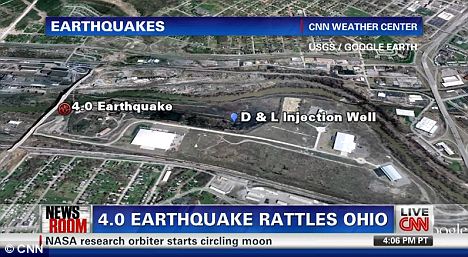Ohio Earthquakes & Fracking
January 1st, 2012
Earthquake in Youngstown, Ohio, the epicenter just a hop, skip and a jump from the D&L Injection Well, pictured above.
Elisa Young in Youngstown sent me this link this morning, noting that “on this Diane Rehm segment the industry specifically states on the air that earthquakes of 2.0 or less (like they can control an earthquake in progress) are beneficial to the drilling company because it shows them the fracking is working. …but fracking and injection don’t induce seismic activity in Ohio… ” The section on earthquakes starts at 28:12.
If you don’t have a copy yet, if you haven’t read it, get with it, learn about gas migration and earthquakes, errrrr… seismic events (copies are getting harder to find, price is going up, but I’m glad because it means that people are paying attention and reading this MUST READ book):
Earthquakes have becoming more and more common in Ohio, as in Arkansas, Pennsylvania, Oklahoma, and yes, there is a trend, a connection, and it’s GAS. In this Youngstown, OH case, it’s related to injecting fracking waste into the ground near a fault. How on earth did they get a permit to do this, anyone with half a brain would know that if you’re pumping in, there is bound to be a response!
Ohio’s “Are you ready for an earthquake?” page!
Here’s a sample, from the Columbus Dispatch:
State links quakes to work on wells
By Joe Vardon
The Columbus Dispatch Sunday January 1, 2012 11:34 AM“The 5-mile radius, we were told by our geologists, is an adequate buffer zone” for the fault line, Zehringer said. “There are four other wells, none of them active, but we’re not going to allow any activity to take place in these wells.”
Michael Hansen, of the Ohio Seismic Network, said that even though Northstar No. 1 was shut down Friday, there is still potential for more quakes, although the magnitude of yesterday’s quake may have relieved some of the pressure near the fault line.
There are 177 injection wells throughout the state. Zehringer and other officials, speaking on a New Year’s Eve conference call, said the single Youngstown well is the only one of its kind that’s been related to seismic activity since the state started using them in the 1970s.
Kasich officials also stressed that the months-long shaking in Youngstown is not a result of hydraulic fracking — a procedure used to extract oil and gas out of rock formations such as the Marcellus and Utica shale. Discoveries of oil and gas in the shale rock in eastern Ohio has sparked hopes for an economic boon in the state’s Appalachian region.
State Rep. Robert F. Hagan, D-Youngstown, called for a statewide moratorium on injection wells. Hagan said he asked the U.S. Environmental Protection Agency to intervene because of the possibility of another quake.
“We don’t want to overreact,” said Zehringer, who suggested that a wider moratorium in well activity “could devastate the economic livelihood of thousands of Ohioans.”
The magnitude 4.0 quake that struck yesterday afternoon in McDonald, outside Youngstown, is the largest of the 11 quakes that originated there, Hansen said.
Residents said a boom accompanied the shaking yesterday. Sheriff’s dispatchers from several counties in the area said there were no immediate reports of damage.
Rick Simmers, chief of oil and gas management for the ODNR, said a daily average of about 5,000 42-gallon barrels of brine water — a byproduct of oil and gas drilling — were pumped into the well, down to 9,200 feet. He said a majority of the water comes from Pennsylvania wells.
Gov. John Kasich, who is vacationing with his family in Florida for the holidays, was in constant contact with Zehringer and other senior staff members throughout the day yesterday, communications director Scott Milburn said. “The governor directed director Zehringer to put public health and safety first and to make a response that is reasonable and appropriate and based on science,” Milburn said.
The well’s owner, Northstar Disposal Services LLC, which agreed to stop injecting brine into the well on Friday, applied for and received licensing under the Strickland administration, Kasich spokesman Rob Nichols said. The No. 1 well has been active since December, 2010, according to Nichols.
Information from The Plain Dealer was included in this story.

Leave a Reply